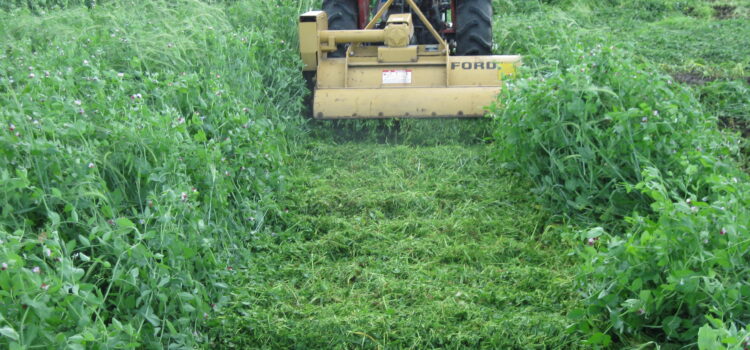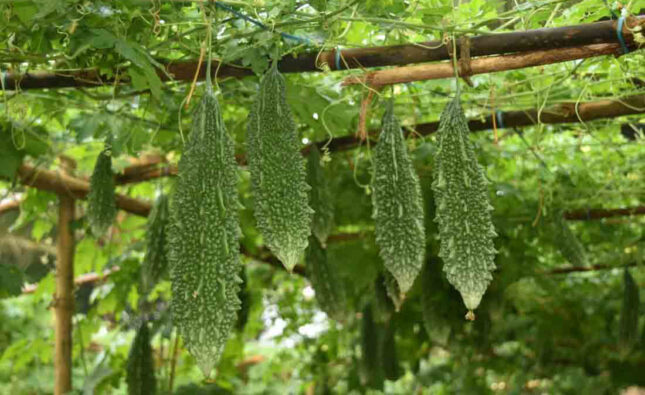Green manure refers to the practice of growing specific plant species and then incorporating them into the soil to improve its fertility and overall health. It involves intentionally sowing and growing plants that are later turned into the soil while still green or when they reach a specific growth stage.
Green manure crops are typically fast-growing plants, such as legumes (e.g., clover, vetch, peas, or beans) or certain grasses. These plants are chosen for their ability to fix nitrogen from the atmosphere, which helps enrich the soil. Nitrogen fixation occurs through a symbiotic relationship between leguminous plants and specific bacteria present in their root nodules. As the plants grow, they take up nitrogen and other nutrients from the soil, effectively trapping them in their tissues.
When the green manure crop is mature enough but before it starts to flower and set seed, it is cut down or uprooted and incorporated into the soil. The green plant material is left to decompose, adding organic matter to the soil. During the decomposition process, nutrients are gradually released back into the soil, improving its structure, nutrient content, and water-holding capacity.
Role Of Green Manure in Soil Fertility
Green manure plays a crucial role in improving soil fertility through various mechanisms. Here are the key ways in which green manure contributes to soil fertility:
- Nutrient enrichment: green manure crops, especially leguminous species, have the ability to fix atmospheric nitrogen through a symbiotic relationship with nitrogen-fixing bacteria. As they grow, these plants take up nitrogen and other essential nutrients from the soil, effectively trapping them in their tissues. When the green manure crop is incorporated into the soil, these nutrients are released through the decomposition process, making them available for uptake by subsequent crops. This nitrogen enrichment helps replenish soil nutrient levels and promotes healthy plant growth.
- Organic matter addition: Green manure crops contribute to the organic matter content of the soil when they are incorporated. Organic matter plays a crucial role in soil fertility as it improves soil structure, water-holding capacity, nutrient retention, and microbial activity. It serves as a source of energy and nutrients for soil organisms, including beneficial bacteria, fungi, and earthworms, which support the overall health of the soil ecosystem.
- Soil structure improvement: The extensive root systems of green manure crops help improve soil structure. Their roots create channels and pores in the soil, enhancing aeration and water infiltration. This results in better root penetration, nutrient uptake, and overall plant growth. In heavy clay soils, green manure crops can help break up compacted soil and improve drainage, reducing the risk of waterlogging.
- Weed suppression: Dense green manure crops can effectively smother and suppress weed growth. They compete with weeds for light, water, and nutrients, reducing weed populations and minimizing competition with subsequent crops. This helps to reduce the reliance on herbicides and manual weed control methods, leading to more sustainable and eco-friendly weed management.
- Erosion control: The growth of green manure crops provides ground cover, protecting the soil from erosion caused by wind and water. The dense vegetation and root systems of these crops help hold the soil in place, preventing soil particles from being washed away or blown off. This is particularly important in areas prone to erosion, such as sloping fields or areas with heavy rainfall. By incorporating green manure into agricultural practices, farmers can improve soil fertility, reduce nutrient depletion, enhance soil structure, control weeds, and mitigate erosion. These benefits contribute to sustainable and long-term soil health, ensuring the productivity and sustainability of agricultural systems.
Which Plant Species are used for Green Manure
Several plant species are commonly used for growing green manure. The selection of species depends on factors such as climate, soil type, intended purpose, and crop rotation requirements. Here are some popular plant species used for green manure:
- Legumes: Leguminous plants are especially valued for their ability to fix atmospheric nitrogen through a symbiotic relationship with nitrogen-fixing bacteria. Common leguminous green manure crops include:
- Clover (e.g., red clover, white clover, crimson clover)
- Vetch (e.g., hairy vetch, common vetch)
- Peas (e.g., field peas)
- Beans (e.g., fava beans, cowpeas)
- Grasses: Certain grass species are utilized as green manure due to their ability to improve soil structure and add organic matter. They also help suppress weeds. Popular grasses for green manure include:
- Rye (e.g., cereal rye)
- Oats
- Barley
- Annual ryegrass
- Mustard family plants: Plants from the mustard family, known as Brassicaceae, are commonly used as green manure because they have biofumigation properties, meaning they release natural compounds that help suppress soil-borne pests and diseases. Examples include:
- Mustard (e.g., Indian mustard, white mustard)
- Radish (e.g., oilseed radish, forage radish)
- Rapeseed (canola)
- Buckwheat: Buckwheat is a fast-growing plant that is often grown as a green manure crop due to its ability to suppress weeds, add organic matter, and improve soil structure. It performs well in poor or acidic soils and attracts beneficial insects.
- Sunn hemp: Sunn hemp is a tropical legume that is highly valued as a green manure crop in warm climates. It is known for its ability to fix nitrogen, suppress weeds, and improve soil health.
- Fallow legumes: Some leguminous plants are specifically grown as green manure during fallow periods to maintain soil fertility and prevent soil erosion. Examples include:
- Alfalfa
- Medics (e.g., barrel medic, black medic)
These are some examples, and there are many other plant species that can be used as green manure depending on regional suitability and specific goals. It is important to select species that are appropriate for the local climate, soil conditions, and farming practices to maximize the benefits of green manure.






